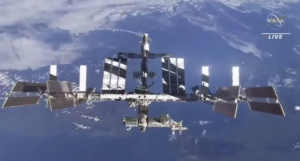SpaceX Cargo Dragon To Demonstrate ISS Reboost
SpaceX launched its 31st cargo mission to the International Space Station this evening. As usual it is delivering several tons of supplies and scientific experiments, but one difference is that for the first time the Dragon spacecraft will be used to reboost the ISS. The primary purpose of the test is to collect data SpaceX needs to develop the U.S. Deorbit Vehicle NASA will use to send the ISS into the ocean at the end of its lifetime.
SpaceX and Northrop Grumman deliver supplies to the ISS under NASA’s Commercial Resupply Services (CRS) contract. This evening’s launch, SpaceX CRS-31 or SpX-31, lifted off at 9:29 pm ET and is scheduled to dock at the ISS at 10:15 am ET tomorrow.
Liftoff of Dragon’s 31st Commercial Resupply Services mission to the @Space_Station! pic.twitter.com/MPRoutKS3t
— SpaceX (@SpaceX) November 5, 2024
The International Space Station is a partnership among the United States, Russia, Japan, Canada and 11 European countries working through the European Space Agency. Two days ago it celebrated its 24th year of permanent occupancy.

During all that time, international crews rotating on roughly six-month schedules have been living aboard the multi-modular facility and need to have food, water, equipment, and other supplies delivered many times a year. Russian Progress spacecraft, Northrop Grumman’s Cygnus, and SpaceX’s Cargo Dragon currently perform those duties. Japanese HTV spacecraft did so in the past and will again when the new version, HTV-X, is ready. Europe also had a cargo vehicle, ATV, but discontinued flights in 2014.
As critical as they are, these resupply missions are so routine they usually attract little attention. What’s notable about this one is that it will be SpaceX’s first attempt to use Cargo Dragon for ISS reboost and attitude control.
The ISS needs to be periodically reboosted to compensate for atmospheric drag and maintain the correct altitude. Throughout the ISS’s lifetime, this task has been performed by Russian Progress cargo spacecraft or thrusters on Russia’s Zvezda module.
In 2018, Northrop Grumman did a reboost test using Cygnus, but it was not until 2022, as Russia was threatening to invade Ukraine and questions arose about Russia’s commitment to the ISS, that NASA started using it operationally. Cygnus’s reboost capabilities are quite limited compared to Progress and Zvezda, however, and Russia continues to conduct the vast majority of reboost operations.
Cargo Dragon’s capabilities also are limited, but Bill Spetch, NASA ISS Operations Integration Manager, told reporters today that “this is an important flight test objective for this mission as we continue to increase the capabilities of all the vehicles on ISS.”
Another objective is for SpaceX to collect data needed for the U.S. Deorbit Vehicle (USDV) the company is building for NASA to deorbit the ISS at the end of its lifetime. The ISS partners were planning to use Progress vehicles to deorbit ISS, but after Russia’s invasion of Ukraine NASA decided an alternative was necessary. The agency selected SpaceX to build it based on the Dragon design.
NASA and SpaceX are targeting Friday, November 8, for the demonstration. SpaceX Director Flight Reliability Jared Metter said today “the data we’re going to collect from this reboost and attitude control demonstration will be very helpful in performing SpaceX analyses on how the system performs.”
UPDATE: The reboost successfully took place on November 8.
SpX-31’s main task is delivering about 6,000 pounds of supplies, equipment, and experiments, however. Among them is a unique cubesat from Japan’s Kyodo University and Sumitomo Forestry called LignoSat.

Made of magnolia wood, NASA’s ISS Deputy Chief Scientist Megan Everett said today that “researchers hope this investigation demonstrates that a wooden satellite can be more sustainable and less polluting than conventional satellites.” Wood should completely disintegrate during reentry instead of leaving tiny particles in the atmosphere. The 10-cubic-centimeter cubesat has sensors to monitor temperature and strain on the wooden structure. It also is carrying an amateur radio payload to test communications through wood.
SpX-31 was SpaceX’s 105th Falcon 9 launch this year and the 400th successful Falcon launch overall. The booster, on its fifth flight, returned to land at Cape Canaveral Space Force Station.
Falcon 9 launches Dragon to the @Space_Station, completing our 400th successful Falcon launch! pic.twitter.com/GySOycPDMO
— SpaceX (@SpaceX) November 5, 2024
User Comments
SpacePolicyOnline.com has the right (but not the obligation) to monitor the comments and to remove any materials it deems inappropriate. We do not post comments that include links to other websites since we have no control over that content nor can we verify the security of such links.